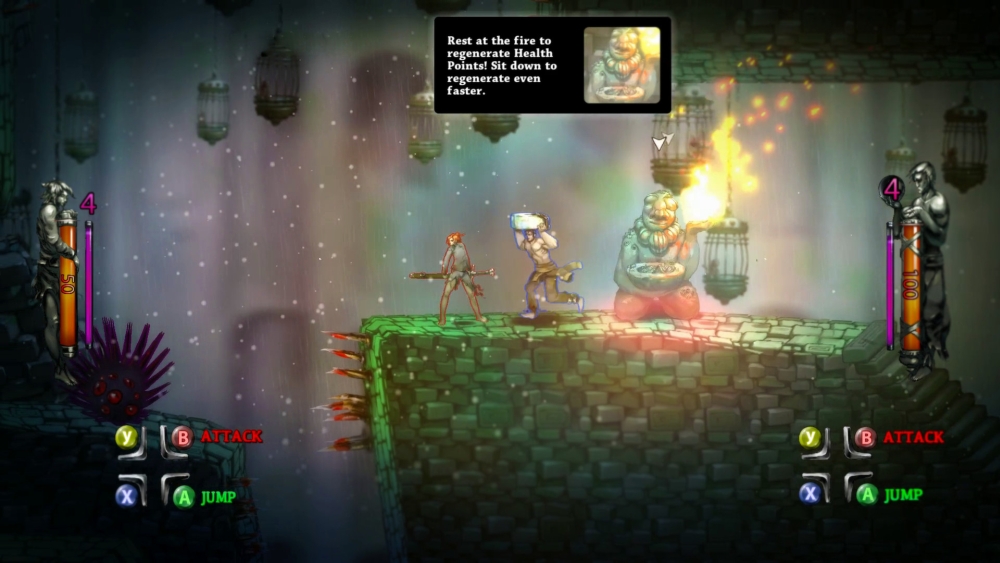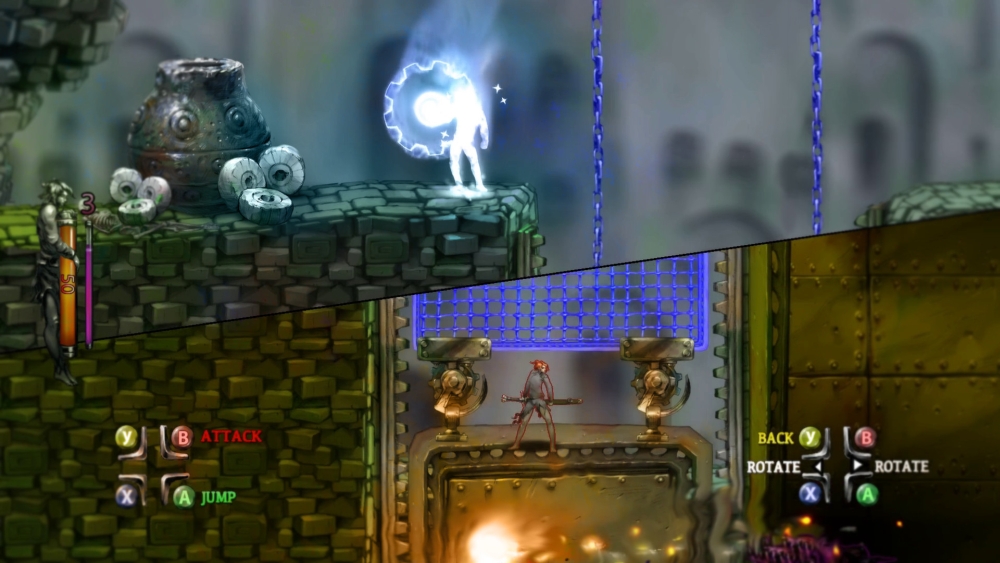

Action adventure games are usually a solo affair. Drop a player into a dark world, give them some swords to swing and some things to upgrade, then let them run around for a few hours before showing an ending. Hooray, you just metroidvaniaed! If you want co-op, though, the genre usually sends you elsewhere. Enter TRISTOY, a short platform adventure game that not only allows for co-op play, it requires it.
If you've ever read a Michael Moorcock book, you'll feel right at home in TRISTOY's fantasy world. The setting and backstory aren't filled out with a ton of detail, but what's there is intriguing, and it makes you want to hear more. Prince Freedan and Stayn are imprisoned in Tristoy, a towering dungeon of rock situated in the center of the Sea of Shards. Freedan wants to escape so he can rescue the kidnapped Freya, whereas Stayn wants to escape so he can get his wand back. Different end goals, but since both of them want to escape, they've got the perfect excuse to work together.

One player controls Freedan, a small, spritely character who wields a sword. The other player gets Stayn, a wizard who uses a stone wheel on a rope like a yo-yo of doom. Each character's abilities let them do certain tasks better than the other. Freedan can double jump, for example, but his sword can't take out enemies like Stayn's wheel can. Stayn also has his gyromantic skill that lets him manipulate certain pieces of machinery. It sets up a very natural atmosphere for cooperation.
Freedan and Stayn strut through a few dozen short levels that connect on a world map. There isn't much in the way of backtracking, branching paths or exploration, so you'll spend most of your time pushing through stages before pausing for an intense boss battle. Puzzles are generally limited to finding the right button to stand on. Sometimes the characters will need to split up and stand on separate switches at the same time in order to proceed. Really, though, you won't break your brain puzzling through TRISTOY. You might break your controller, but that's a tale for the second page of the review.

Storytelling is one of TRISTOY's strongest features, not only because the world is interesting, but also because you have so much control over conversations. Freedan and Stayn encounter NPCs and speak to each other quite often, giving us ample opportunity to indulge in multi-choice dialogue. Options pop up for each character during conversations, allowing players to push the narrative in slightly different directions. The choices you make affect how characters feel and act towards each other at the end of the game. Notes like "Stayn will remember this" send a little chill down your spine, especially when you just made Freedan be a total jerk towards him. The whole thing culminates in a multitude of different endings, giving TRISTOY a touch of replay value.
Co-op works well in TRISTOY, which is good since there's literally no other way to play. Stayn and Freedan move independently of each other but still have to work together in order to proceed. This is facilitated by the game's unique dynamic splitscreen. Instead of chopping the screen in half every time the characters part ways, tilts and rotates the divide depending on where the characters are and what they're doing. It's a little disorienting when each player stares at a separate part of the same level-wide event, but it makes exploration a lot easier in the long run.
Now for the doom and gloom: bugs, cheap deaths, and spotty online co-op. The bugs in TRISTOY aren't the cute "Aw, look, the texture blinked out for a second" type of bugs. They're more of the "That platform didn't move when I pressed the button" or "The final boss battle didn't trigger" nature. Both of those were real issues we ran into while playing. Workarounds include crossing your fingers, burning incense, and wandering the local terrain for half an hour hoping two lines of code meet and fall in love. The issues don't seem to affect every one who plays, but when they do, oh man are they bad.
Another bug (sorry, "feature") relates to save spots and restarting the game. When you die, TRISTOY bumps you back to the most recent checkpoint and deducts one of your lives. When you lose all of your lives, you start back at the last save point. The problem is save points also act as checkpoints, so when you die and are sent back to the save point, you lose a life and the game is saved, making the life loss permanent. In practice this doesn't affect the gameplay all that much, but it's painful to see your lives siphoned away like that, especially when so many of those deaths are honestly not your fault.
Cheap deaths are the bane of modern video games. It's one thing to challenge players to overcome obstacles through practice and gradual mastery. It's another to throw things at you that you can't avoid or make it unclear when something will injure/kill you. You'll find a fair amount of the latter in TRISTOY, largely because of unclear platform edges and hitboxes that don't line up with the artwork. Go on, try to run to the end of a ledge and leap across. If you miss it by half a step, you're done for. Judging that half a step isn't as easy as looking at the graphics, either. TRISTOY's visuals have a very smooth, natural look, but it makes it difficult to judge your character's position, resulting in more deaths than you'll admit to in polite company.
One more note about cheap deaths. TRISTOY employs layered walking paths from time to time, allowing you to hop onto walkways in the fore- or background. These create some unique situations where you can scoot around enemies and find new ways forward, but the tradeoff just isn't worth the sacrifice. You can only swap between layers when you're standing on solid ground. Jump off a level three background and you have to land on a level three background. You can't switch in mid-air, there's no indication which layer you're on, and the game won't bother to catch you on another level. Translation: you gonna die, and you gonna be mad when you do.
And finally, online co-op. Some players, myself included, experience jittery visuals when playing online co-op games. The issue sets in after about 20 minutes of play, and it looks like someone's mounted your monitor to a paint mixer. Quitting and re-entering the game usually fixes it, which is good since the game becomes unplayable after a certain point.
TRISTOY's problems only stir up the vinegar only because the rest of the game is such an engaging experience. The multiple choice dialogues, story and gameplay work well, and you'll want to find out what happens to both the main characters and some of the NPCs as the game progresses. The artwork is amazing, everything from the backgrounds to the animated characters look like they ripped from that nightmare I had when I was 12. The real scarring experience ends up being the glitches and gameplay issues listed above. Despite TRISTOY's focus on great storytelling, the feeling you walk away with after your three hours of gameplay is lingering frustration. Not even co-op can fix that, unfortunately.